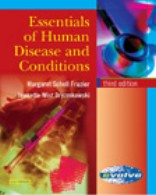|
|
|
| |
 |
|
|

|
 推薦指數:
推薦指數:





|
|
- 內容介紹
|
Essentials of Human Diseases and Conditions, 3rd Edition
By Margaret Schell Frazier, RN, CMA, BS and Jeanette Drzymkowski, RN, BS
Approx. 848 pages, Approx. 350 illustrations, Copyright 2004
Description
Offering quick access to the pathological conditions most commonly seen in the physician’s office, this portable text/reference is ideal for administrative and clinical medical assistants who have a wide range of responsibilities — including billing, coding, telephone screening, taking patient examinations, understanding diagnostic and treatment procedures, and putting together patient education programs. Thoroughly revised and updated to reflect the changes in the field, this third edition features an enhanced format with a description of over 500 conditions and disorders, their ICD-9-CM codes, signs and symptoms, patient screening, etiology, diagnostic assessment and clinical tests, treatment options, prognosis, prevention, and patient teaching. A companion website provides multiple weblinks for all diseases and conditions profiled in the book.
Key Features
Disease presentations follow a normal pathological progression — with descriptions, related ICD-9-CM codes, symptoms and signs, patient screening, etiology, diagnosis, treatment, prognosis, prevention, and patient teaching — to help readers conceptualize disease pathology and better apply information.
Enrichment and Alert boxes offer readers information, clarification, and precautions next to the related topic in the text to improve the awareness of diseases as they affect people every day.
Diseases are presented in an encyclopedia-type format, to break the text into easy-to-understand topics, and to make disease classifications easier to locate within subject areas.
Concise descriptions of disorders help readers quickly review information.
The ICD-9-CM code for each disorder provides a reference point for health care providers when coding for reimbursement.
Symptoms and signs of each disorder are discussed in a logical format to enlighten readers on what patients may report and what the clinician will be finding during the examination that is characteristic of the disorder.
Information on telephone screening provides suggestions for scheduling and for emergency intervention concepts.
Discussions of diagnostic testing, laboratory, and imaging are included along with physical and emotional findings.
Various treatment options are included for each disorder including current drug therapies.
A section on prognosis provides readers with the possible outcome for each disorder.
Coverage of prevention provides the reader with information necessary to help educate the patient on preventive measures.
A section on patient teaching provides suggestions for patient instruction and teaching.
Appendix provides panic values and other valuable information in a concise and readable form.
Appendix contains mailing addresses and telephone numbers to help readers provide patients, clients, or family members with agencies that may be contacted for additional information or assistance.
A glossary includes the Spanish translations of each word, and defines words that are bold in the text to help readers understand the terminology used throughout the text.
Content emphasizes total patient care with the inclusion of unique discussions on childhood disorders and conditions, normal pregnancy and complications, mental health disorders, and trauma or emergency care options.
Student-friendly features include learning objectives, key terms with pronunciations, review questions, and case scenarios.
Table of Contents
1. Mechanisms of Disease, Diagnosis, and Treatment 2. Developmental and Childhood Diseases and Conditions 3. Immunological Diseases and Conditions 4. Diseases and Conditions of the Endocrine System 5. Diseases and Conditions of the Eye and Ear 6. Diseases and Conditions of the Integumentary System 7. Diseases and Conditions of the Musculoskeletal System 8. Diseases and Conditions of the Digestive System 9. Diseases and Conditions of the Respiratory System 10. Diseases and Conditions of the Circulatory System 11. Diseases and Conditions of the Urinary System 12. Diseases and Conditions of the Reproductive System 13. Neurological Diseases and Conditions 14. Mental Disorders 15. Disorders and Conditions Resulting from Trauma Appendix A: Resource Reference Guide Appendix B: Common Laboratory and Diagnostic Tests Appendix C: Therapeutic Effects of Drugs on the Body Glossary
|
|
|

